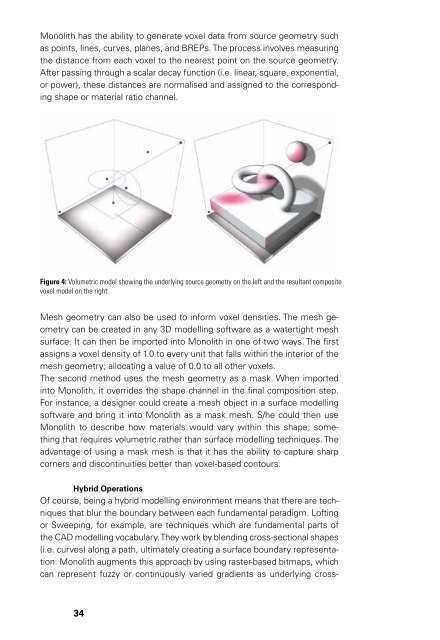Mixed Matters
ISBN 978-3-86859-421-8
ISBN 978-3-86859-421-8
You also want an ePaper? Increase the reach of your titles
YUMPU automatically turns print PDFs into web optimized ePapers that Google loves.
Monolith has the ability to generate voxel data from source geometry such<br />
as points, lines, curves, planes, and BREPs. The process involves measuring<br />
the distance from each voxel to the nearest point on the source geometry.<br />
After passing through a scalar decay function (i.e. linear, square, exponential,<br />
or power), these distances are normalised and assigned to the corresponding<br />
shape or material ratio channel.<br />
Figure 4: Volumetric model showing the underlying source geometry on the left and the resultant composite<br />
voxel model on the right.<br />
Mesh geometry can also be used to inform voxel densities. The mesh geometry<br />
can be created in any 3D modelling software as a watertight mesh<br />
surface. It can then be imported into Monolith in one of two ways. The first<br />
assigns a voxel density of 1.0 to every unit that falls within the interior of the<br />
mesh geometry; allocating a value of 0.0 to all other voxels.<br />
The second method uses the mesh geometry as a mask. When imported<br />
into Monolith, it overrides the shape channel in the final composition step.<br />
For instance, a designer could create a mesh object in a surface modelling<br />
software and bring it into Monolith as a mask mesh. S/he could then use<br />
Monolith to describe how materials would vary within this shape; something<br />
that requires volumetric rather than surface modelling techniques. The<br />
advantage of using a mask mesh is that it has the ability to capture sharp<br />
corners and discontinuities better than voxel-based contours.<br />
Hybrid Operations<br />
Of course, being a hybrid modelling environment means that there are techniques<br />
that blur the boundary between each fundamental paradigm. Lofting<br />
or Sweeping, for example, are techniques which are fundamental parts of<br />
the CAD modelling vocabulary. They work by blending cross-sectional shapes<br />
(i.e. curves) along a path, ultimately creating a surface boundary representation.<br />
Monolith augments this approach by using raster-based bitmaps, which<br />
can represent fuzzy or continuously varied gradients as underlying cross-<br />
34


















